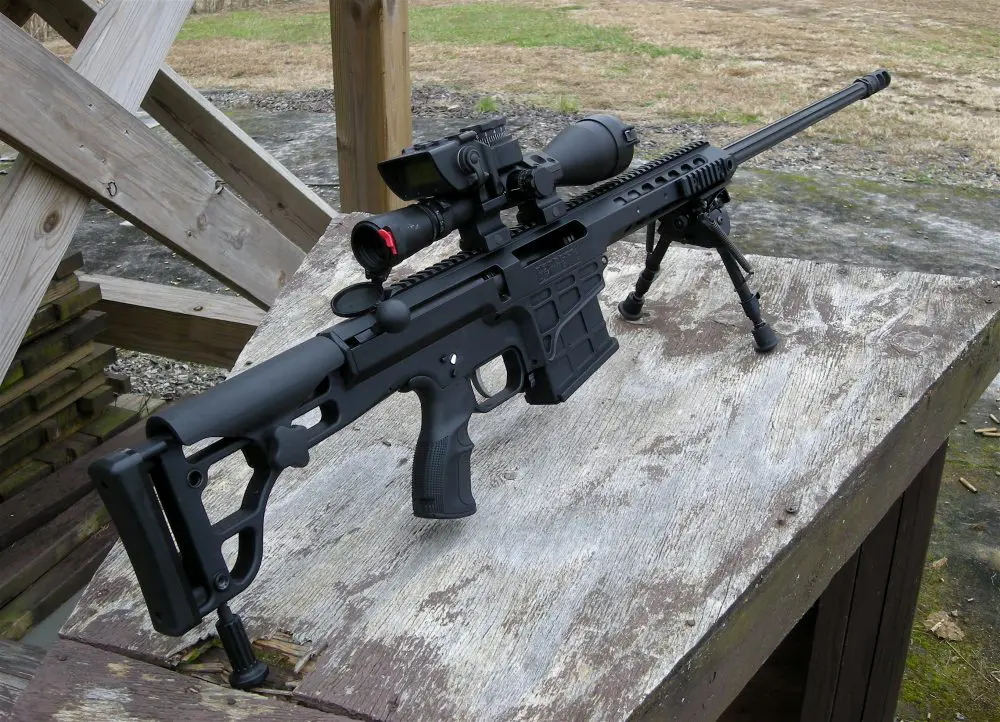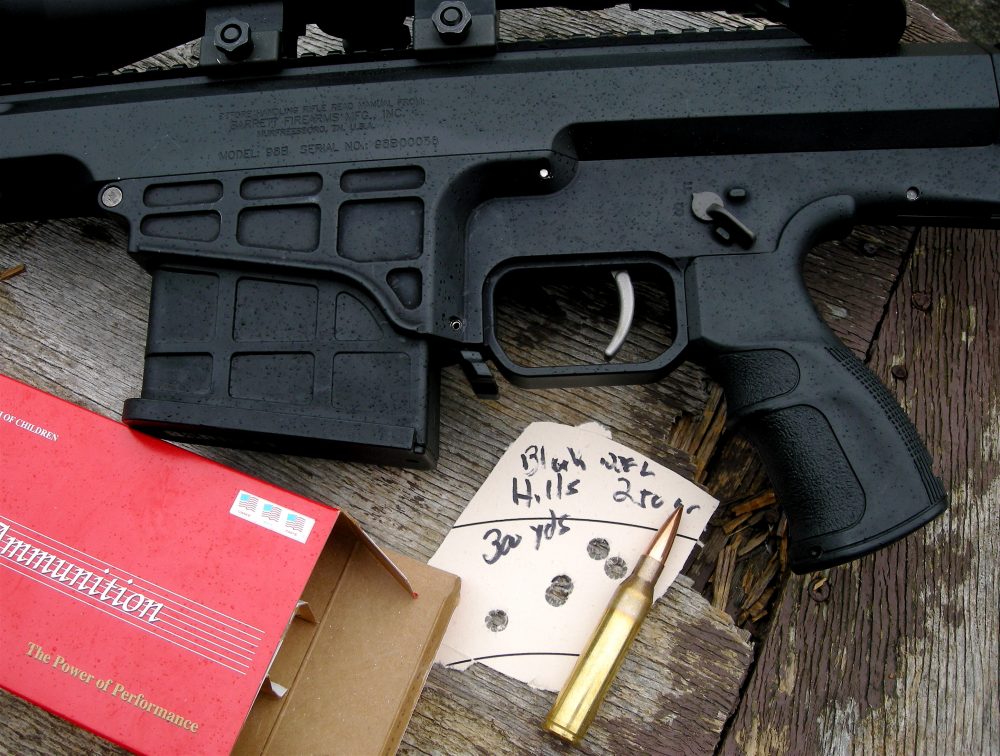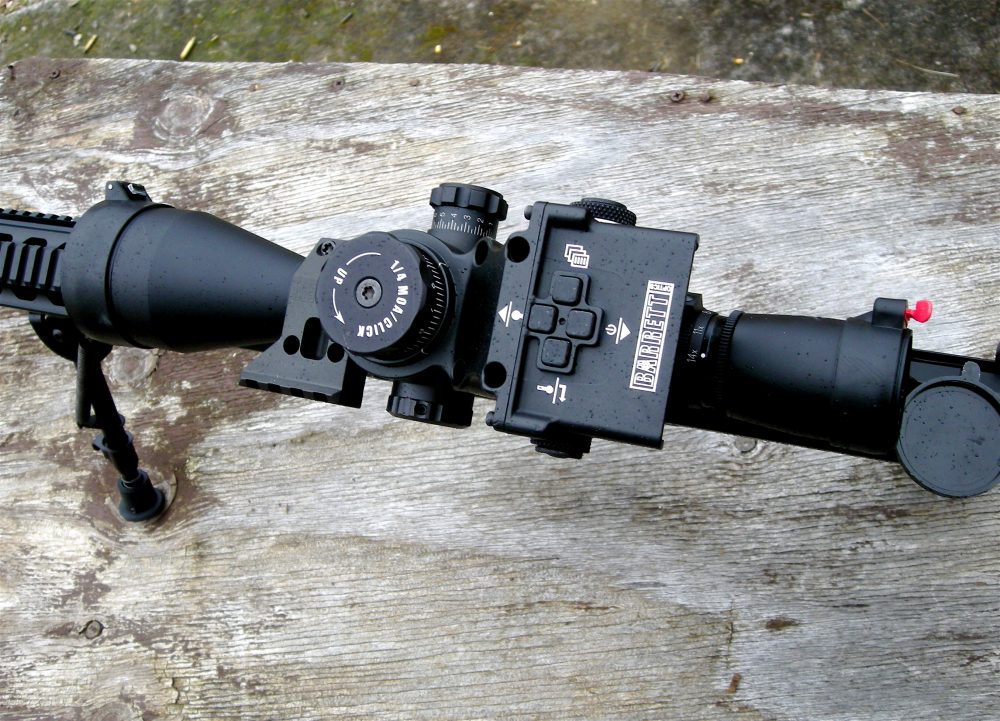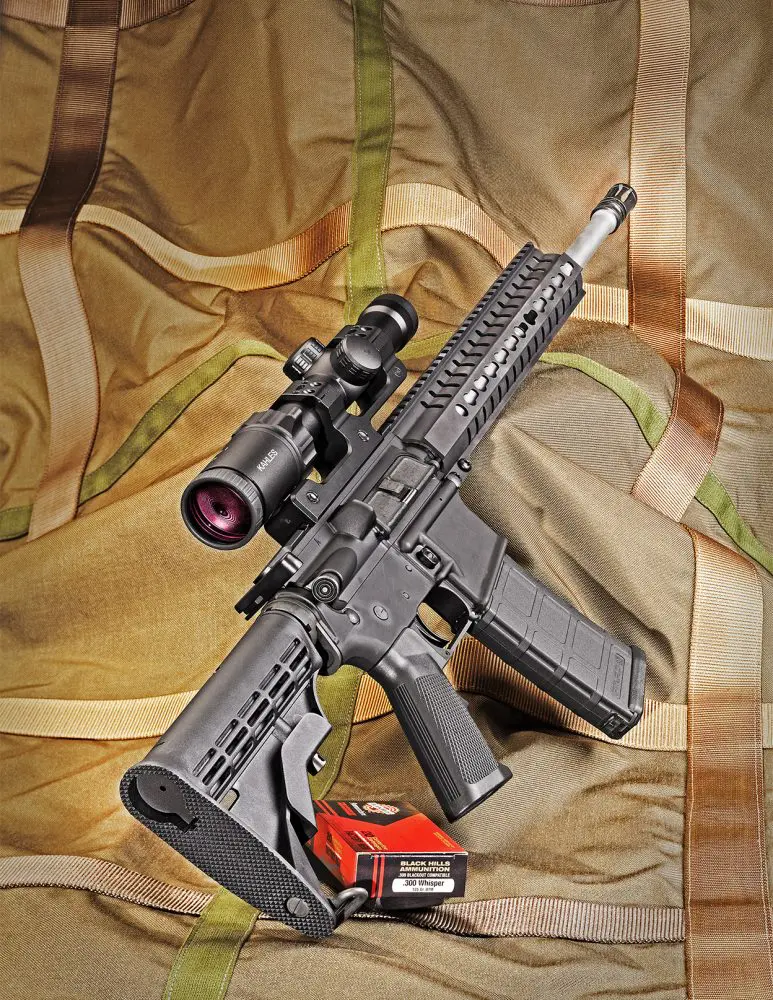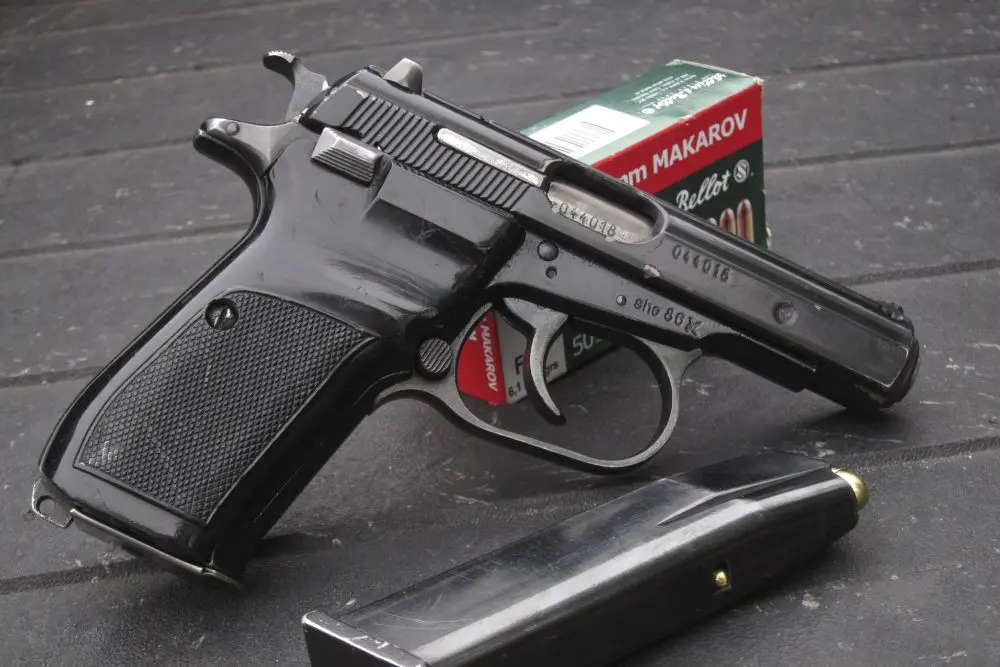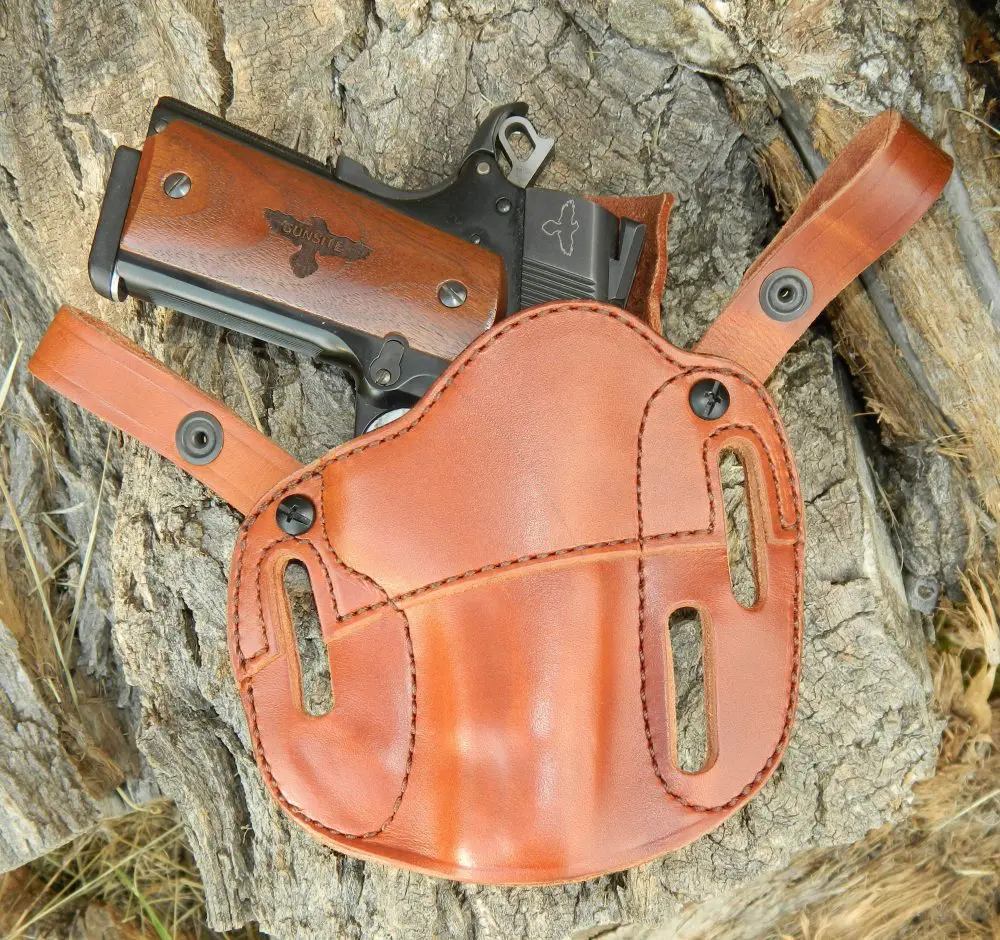I started shooting .338 Lapua sniper rifles because I write about military special ops units, and many of them have started using .338 Lapua rifles. Some, in fact, now use the .338 Lapua chambering in their primary long-range rifles. This choice is understandable if you look closely at the cartridge. It has the power to reach out to 1,200-1,500 yards. Really skilled shooters can use it at even longer ranges.
Though not designed as an anti-materiel rifle, the .338 Lapua round does offer better performance on hard targets than .308 or .300 Win Mag. And rifles in .338 Lapua are generally more portable than those chambered for the .50 BMG round.
98 Bravo on its bipod and monopod. BORS atop Leupold scope.
For law enforcement tactical teams that may want the longer-range capabilities of the .338 Lapua, there is an advantage as well. Unlike the heavier .50s, which have BMG (Browning Machine Gun) as part of their designation, Lapua does not have as much of a negative connotation in nonmilitary usage. Of course, some reading this will realize the irony is that the .338 Lapua was actually designed from the beginning as a sniper round, not a hunting round adapted to sniper—a man-killing round from the beginning!
No other name is so associated with long-range sniper as Barrett; hence, I have been anxious to try the Barrett 98 Bravo .338 Lapua rifle since I first heard about it. I felt that the combo of Barrett quality and the .338 Lapua round would be a fruitful one.
As should be expected with a Barrett, the 98B is very ergonomic. For example, the safety is a lever in the same position as that on an M4 and operates in the same way. The magazine release is a paddle type that may be easily operated with the support hand. When the shooter is in the prone position using the bipod, a mag change may be easily carried out by canting the rifle to the side without lifting it.
The 98B’s stock incorporates an adjustable cheek pad as well as a rubber butt pad. There is also an adjustable monopod for when the shooter must stay on target for an extended period. Since the stock is actually machined from the same piece of stock as the receiver, recoil is well distributed, especially with the well-designed recoil pad.
Five-shot group of 1 7/8 inches at 300 yards using Black Hills 250-gr. Match King loads.
The pistol grip is the best designed and most comfortable I have used on a heavy-duty sniper rifle and is an aid to comfort when shooting the rifle. A good-sized ball forms the bolt handle and is well located so that the hand finds it and operates it quickly with no need to lose the sight picture.
Trigger pull from the factory runs between two and three pounds and breaks very smoothly. The trigger itself is curved well for comfortable usage. The trigger guard is large enough to allow the use of tactical gloves and most winter gloves.
A full-length top rail will allow the use of just about any scope the shooter desires, as well as night vision optics. A side rail allows the mounting of an illuminator or pointer. If the Barrett Optical Ranging System (BORS) is used, the mount also incorporates a small rail for mounting a pointer.
The 98B’s barrel is 27 inches and fluted with a 1:10 twist. A very effective muzzle brake gives the rifle a bit of a push forward as gases escape, thus lessening recoil. Although I do not find the .338 Lapua round overly punishing, any recoil reduction is appreciated.
View of BORS from the top. Four buttons control its various functions. Larger elevation knob replaces standard Leupold one to work with BORS.
A short Harris bipod is included with the 98B. This compact Harris bipod offers a couple of advantages: it adds less weight and it gets in the way less when moving with the rifle or putting it in or taking it out of a case.
Weight of the 98 Bravo without scope or a loaded magazine is around 13.5 pounds. Overall length is 49.75 inches. Barrett’s ten-round magazine for the 98B appears sturdy and well designed. It is smooth to load and, based on my use so far, very smooth and reliable in feeding. This is a larger capacity magazine than on most other .338 Lapua rifles, and I consider it an advantage since it does not affect the ability to shoot prone or from a rest, yet grants more rounds without a reload, an advantage in a “target-rich environment.”
The 98B I was sent to test came with a Leupold 4.5-14X50 LR/T M1 and the BORS installed and zeroed. Note that the BORS is compatible with an array of Leupold, NightForce, and Schmidt & Bender optics. In simple terms, the BORS is designed to give the military or LE marksman a much greater chance of a first shot hit at long range by helping arrive at a ballistic solution quickly. Of course, it can work for sport shooters as well.
Though 98 Bravo is lighter and more portable than some other .338 Lapua rifles, it still can get heavy when carried over any substantial distance.
The BORS comes with 100 loads preprogrammed in and covers most factory sniper loads. The user may also program in custom loads. To calculate many of the factors needed for a precision shot, the BORS constantly monitors temperature, barometric pressure and degree of angle to the target. A BORS has the capability of serving as a range finder, but it is dependent upon the marksman knowing the distance to the target. Just as does a Mil Dot or other ranging scope, this functions as a good backup, but use of a laser rangefinder is best.
Among the features which may be programmed into the BORS is whether metric or U.S. measurement is being used. The cartridge being used must be selected and range punched in. The BORS will then calculate data for properly dialing in the elevation setting. Windage must still be calculated. The default for zeroing the BORS/scope/rifle combo is 100 yards. This is a simplified description of the BORS, but although it performs a complex function, the device itself is relatively simple to use.
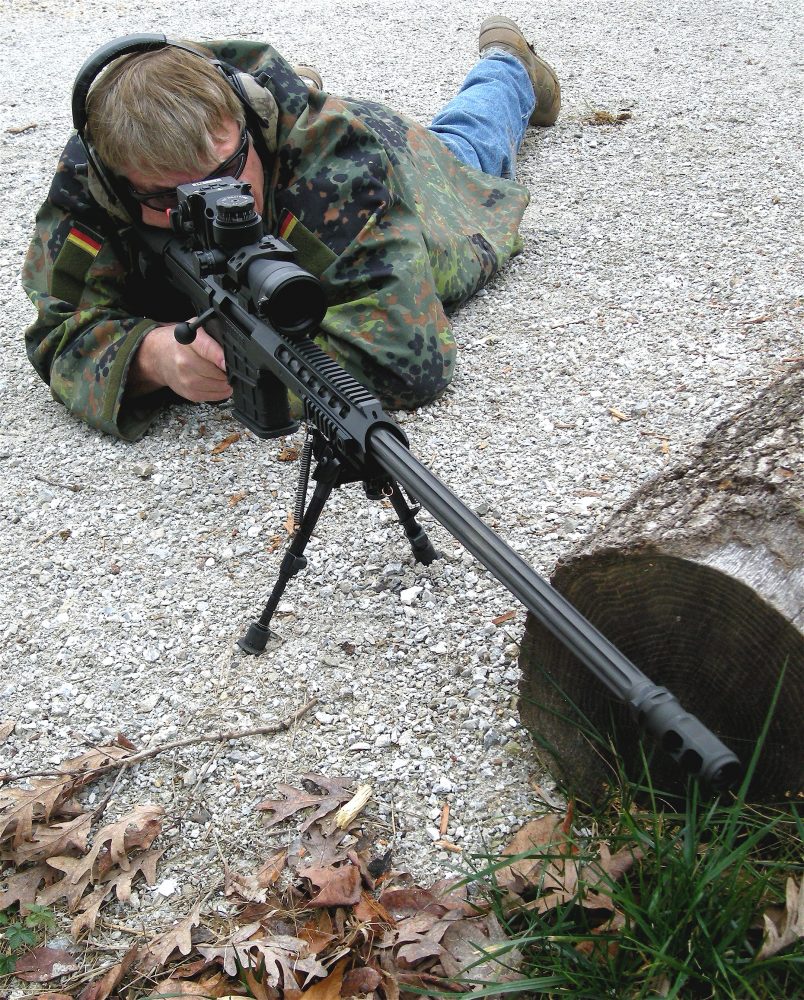
Every loading I’ve tried in .338 Lapua has been quite accurate. For my initial shooting of the 98 Bravo, though, I selected Cor-Bon 250-gr. BTHP and Black Hills 250-gr. Sierra Match King. When testing .338 Lapua rifles, I generally limit myself to 40 rounds at a sitting, literally, since a lot of the rounds for accuracy are fired from the bench. I also fire some rounds prone off the bipod and, in the case of the 98B, a few offhand. I fired 40 rounds of each load in my first session and 40 rounds of each load in my second shooting session, for a total of 80 fired for this column.
I did much of the shooting wearing a ballistic vest. This was partially to test the rifle the way many tactical shooters would be using it, but also as a recoil cushion. I’ve found Kevlar spreads recoil very well. As I normally do with .338 rifles, I fired a few rounds without the ballistic vest. With the vest, recoil did not feel any heavier than firing a .308 without a vest. Without the vest, I would say it felt no worse than firing my Steyr SSG 04 .300 Win Mag without a vest, maybe even a bit less. To put it simply, the 98 Bravo handles recoil well.
As far as accuracy testing, it would have been more of a headline if a Barrett were not accurate than if it were. No worries, the 98B was very accurate. I have aging eyes, so whatever I shoot, a younger and better marksman should be able to top. Nevertheless, at 100 yards I was consistently under an inch for three-shot groups. The best was a little less than .75 inch with Cor-Bon. At 300 yards, I was consistently under three inches and about half the time around two inches. My best was a five-shot group of 1 7/8 inches with Black Hills 250-gr. Four out of the five rounds were actually in an inch.
Since 300 yards was the maximum range at which I was shooting, I did not really use the BORS to get a solution, but did try punching in data to see how it worked. It really is surprisingly simple. I’m no technophobe, but neither do I think anyone will ever suspect me of being a hacker. If I can figure it out, so can most others.
I found the 98 Bravo light and handy enough that I fired three rounds offhand at 100-yard plates and hit on one of them and scared the plates on the other two. I have good arm and shoulder strength, but this is at least a 16-pound rifle with scope, BORS, and full magazine. Still, I would feel more comfortable shooting the 98B offhand than the other .338 Lapuas I’ve used.
I fired one ten-round magazine prone on 200- and 300-yard plates. I hit every time and found the 98B very well designed for prone shooting. Bolt operation is fast and smooth, and I did a magazine change while prone and found it quite smooth if I canted the rifle a bit to the right.
Barrett spent a lot of years working on getting the 98 Bravo right, and they definitely succeeded. This is a great rifle that fires a great cartridge. Before I started shooting .338 Lapua tactical rifles, I didn’t really get how enthusiastic friends were who served in units that used them. Now, I get it!
I wouldn’t change anything on the 98 Bravo, but do have one comment. Because of the way the stock is fabricated along with the receiver, I don’t know if a folding-stock 98B is anywhere in the future. Special operations personnel who may have to carry, climb, be inserted by chopper or boat, etc., with their sniper rifle generally like a folding stock. If Barrett could do a folding stock while retaining the 98B’s ergonomics and accuracy, I would like to see that. If not, it’s still a great rifle.
SOURCES:
Barrett Firearms Manufacturing, Inc.
Dept. S.W.A.T.
P.O. Box 1077
Murfreesboro, TN 37133
(615) 896-7313
www.barrettrifles.com
Black Hills Ammunition
Dept. S.W.A.T.
P.O. Box 3090
Rapid City, SD 57709-3090
(605) 348-5150
www.black-hills.com
CorBon
Dept. S.W.A.T.
P.O. Box 369
Sturgis, SD 57785
(800) 626-7266
www.corbon.com
Leupold & Stevens, Inc.
Dept. S.W.A.T.
P.O. Box 688
Beaverton, OR 97075-0688
(503) 646-9171
www.leupold.com
